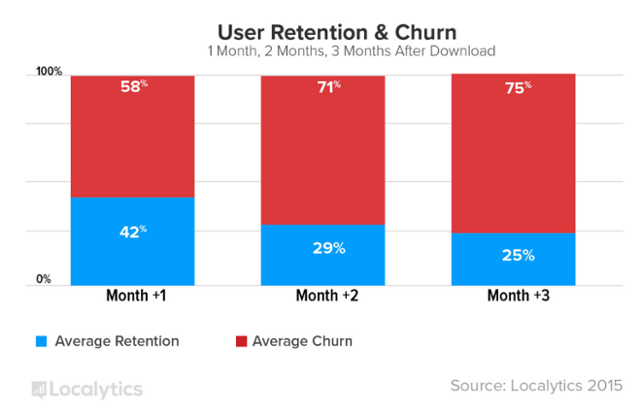How to Improve User Experience and App Retention

The app development journey is far from over after launching in the marketplace. The challenge now turns to user acquisition and retention. In a highly competitive market,
More and more companies are now realizing that user experience is the true competitive advantage which sets the best apart from the rest – Alex Castrounis, Innoarchitech.
App churn is a significant problem for any app in the marketplace. Localytics found that, across all industries, 75% of app users churn within 90 days. Furthermore, on average apps retain only 25% of users over time.

Source: Localytics
App retention relies heavily on providing a positive and engaging user experience. Users will always choose an app that is:
- More appealing and interactive,
- Easier to use and understand,
- Intuitive,
- More rewarding, and
- Better at satisfying their needs.
Therefore, enhancing the user experience is essential for
Keep it Simple
The lack of screen space on a mobile device means that app navigation and usability must be simple and straightforward. A lack of intuitive navigation in the app will lead to
It is important that a user’s first app experience is as seamless as possible. Users tend to make far more errors and are slower when typing on mobile devices. Avoid overwhelming users with data entry. Inputting details into a thousand form fields before even using an app is a surefire way to increase app abandonment. Therefore, it is important your app facilitates ease of use in order to
Improve App Performance
Performance is one of the biggest predictors of mobile app success. Poor app performance can lead to a negative user experience costing you downloads, revenue and brand perception. Dimensional Research found that 80% of app users will only attempt to use a problematic, poor functioning app, 3 times or less. The survey also found that 96% of users stated that app performance is important to them. Therefore, it is essential that your app consistently performs well in order to maintain, or improve, the user experience and perception of your app.
App quality is tied to its performance. According to Akamai, 20% of users expect mobile apps to load instantly. When performance doesn’t meet user expectations, there is a very high chance they will abandon the app.
Mobile pages that are 1 second faster experience up to 27% increase in conversion rate – SOASTA
Performance is dependent on several factors such as the server, mobile device, network and the programming of the app itself. Here are some ways to enhance your app’s performance:
- Compress and resize images to
minimise file size (bytes) without compromising image quality. - Re-use data templates in order to make the app load faster due to fewer templates.
- Load data as it’s needed by splitting up assemblies in order to avoid users waiting longer than necessary to view parts of your app. Preloading data is another technique that can be used so that the data is already there when your users need it.
- Create an offline mode so that in the event the network connection is lost, users can be alerted as to why their action has been interrupted. It is also important to give users an option to save their data, so they can resume the activity when the connection is re-established.
- Monitor and test app performance regularly to ensure the app continues to work as it is intended to and remains compatible with devices.
Related 3 Reasons Native Apps Are Better For User Engagement
Create ‘App Magnets’
In order to decrease churn and increase user engagement, consider introducing additional app tools, games, features, widgets, calculators
Invest in Content
Avoid becoming an ‘orphaned app’; apps that are left as is, with no updates or new content. Recruit writers who can produce quality pieces of content for your app that will keep users engaged. Create content that is original but highly relevant to your users in order to add to their app experience. Steer clear of any content that is internally oriented, instead focus on the end user and building a brand persona that users will love. Remember to remain open to ideas that may be slightly outside of scope.
Another way to enhance the user experience is through combining appropriate content and tone of voice with engaging visual design and the subtle use of transitions. Implementing transitions ensures that your users never confront a dead end in your app. Additionally, users are more likely to continue using your app if the content is grouped together. Doing so allows your users to view the content in digestible chunks, taking away any complexities associated with information search.
Make it Personalised
App users crave
Integrate with Social
It is important to leverage social media by integrating it within your app, that way users can share content with ease. This not only increases engagement but also requires less effort on the user’s behalf, enhancing the user experience whilst keeping them in your branded environment. Social networks are a great way for users to connect and engage with your brand and can help build a community around your app.
Related Strategies for Successfully Launching and Marketing an App
Communicate During Downtime
Another way to enhance the user experience is to communicate during times when your app is loading, computing, rendering an image, or anything that blocks the user from continuing their app experience. It is important to inform users of what is happening during these times in order to validate any delays. There are several tools you can use to communicate to your users, such as a spinning wheel, progress bar, or
Perform Regular Testing
Continue to test your app’s functionality and usability in order to eliminate any bugs and to ensure it works as it is intended to. One way to test your app’s usability is to perform remote user testing which allows you to gather feedback from participants using your app in their natural environment. This provides the opportunity to ‘look over the shoulder’ of someone using your app and find out what they think and feel during use.
The most successful apps regularly perform user testing after each new app update. It is important to test both your target users and niche targets in order to understand what different users are looking for. Be mindful of any Apple or Android mobile operating system updates, as these updates may cause your app to break.
Continue to Gather Feedback
It is essential that users are able to contact you so they can provide feedback and report any bugs found in the app. Implement tools that help provide your users with a voice, such as integrating a communication channel in your app. Collect the feedback, listen to your users and strive to continually improve your app based on these insights. Leveraging this feedback provides you with the opportunity to improve user experience and increase your app’s retention.
Analytics is another important tool to leverage, as they provide insights into where and how your app can be improved. Measuring and monitoring key metrics allows you to understand your users and their usage
Apps are about creating useful and rewarding experiences for your users. Implementing these strategies can help secure your app’s future success by enhancing the user experience and increasing app engagement and retention.
As the app ecosystem continues to evolve, businesses are now leveraging app development platforms for building feature-rich, scalable and


